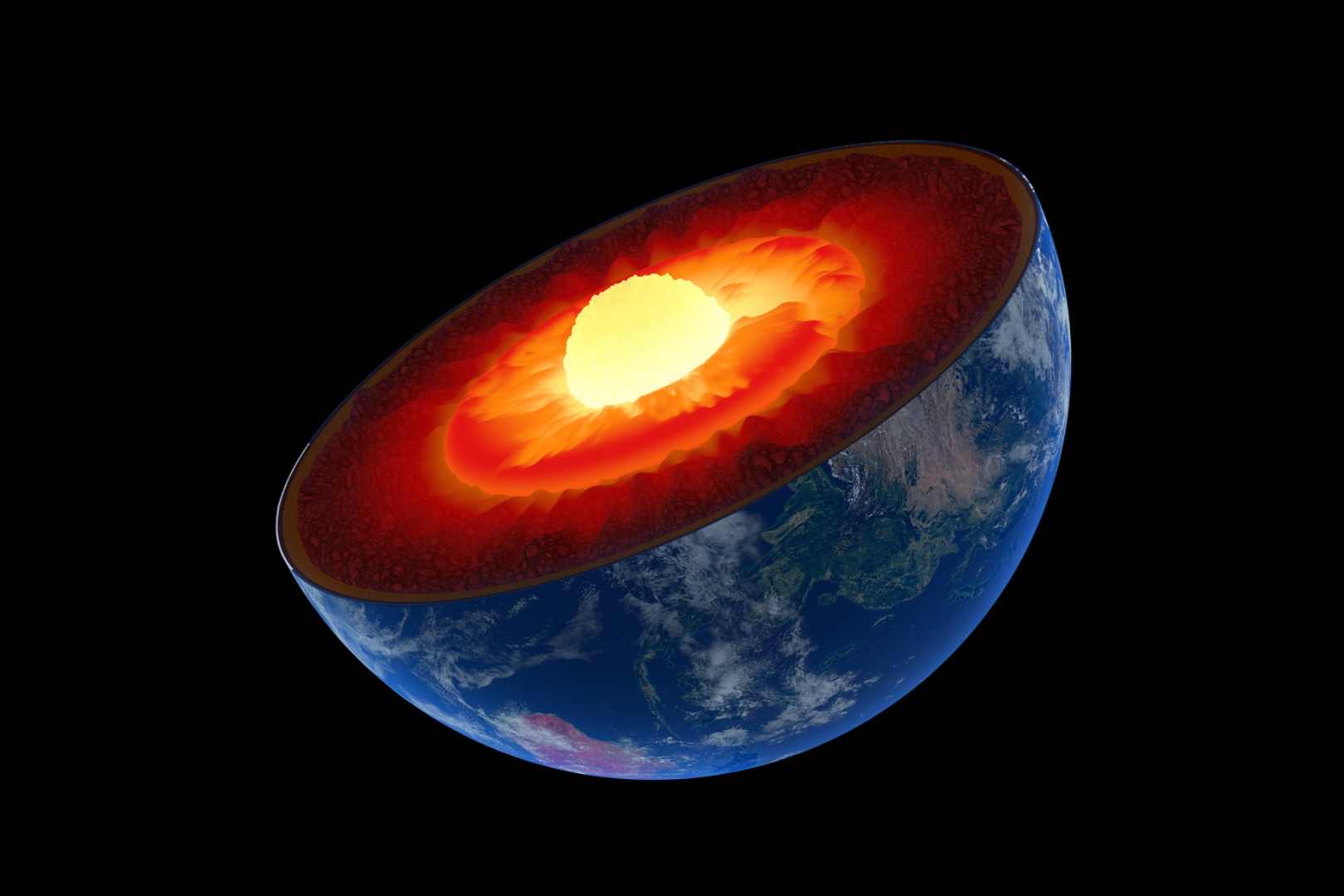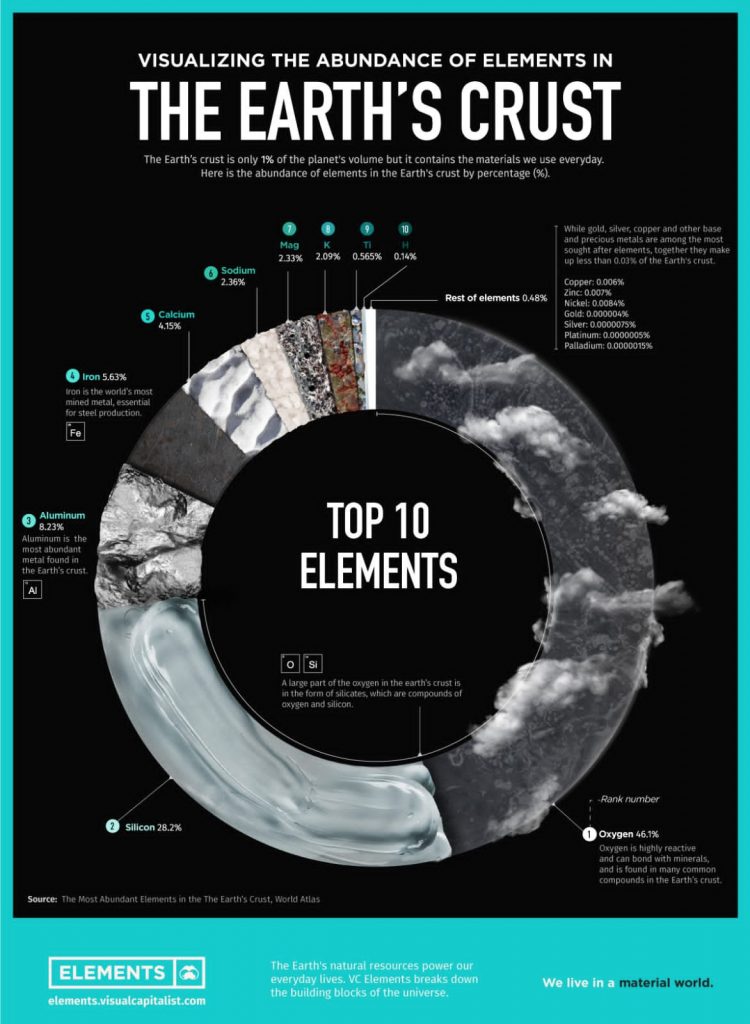10 most abundant elements in the earth’s crust furnishes all of mankind’s fundamental building components. Regardless of the fact that the crust provides the foundation for everything we discover, mine, refine, and build, it only touches the surface of our planet.
After all, the Earth’s deepest layer, the core, accounts for 15% of the planet’s volume, while the mantle accounts for 84%. The crust, a thin layer that ranges in depth from 5-70 km (3-44 miles), accounts for the remaining 1%. Based on data from WorldAtlas, this infographic examines the factors that comprise this one percent.
Elements of the Earth’s Crust
The crust is a hard surface that contains both seas and landmasses. Most elements are only present in trace levels in the Earth’s crust, although a few are plentiful. Its Upper mantle is composed of around 95% igneous rocks, 4% shale, 0.75 percent sand, and 0.25 percent lime. The elements oxygen, silicon, aluminum, and iron account for 88.1 percent of the mass of the Earth’s crust, while the remaining 11.9 percent is made up of 90 other elements.
The Earth’s Crust’s 10 Most Common Elements
| Rank | Element | % of Earth’s Crust |
| 1. | Oxygen (O) | 46.1% |
| 2. | Silicon (Si) | 28.2% |
| 3. | Aluminum (Al) | 8.23% |
| 4. | Iron (Fe) | 5.63% |
| 5. | Calcium (Ca) | 4.15% |
| 6. | Sodium (Na) | 2.36% |
| 7. | magnesium (Mg) | 2.33% |
| 8. | potassium (K) | 2.09% |
| 9. | titanium (Ti) | 0.565% |
| 10. | hydrogen(H) | – 0.140% |
| Total | 100% |
1. Oxygen – 46.1%
Oxygen is by far the most plentiful element in the Earth’s crust, accounting for 46 percent of total mass just short of half. Oxygen is a highly reactive element that forms oxides when it reacts with other elements. Minerals such as stone and quartz (oxides of silicon), rust (oxides of iron), and limestone are common examples of oxides
2. Silicon – 28.2%
As previously stated in the case of silicate, silicon is a common element found in the Earth’s crust. It accounts for around 28% of the crust and may be found in a broad range of minerals and elemental compounds, frequently in combination with oxygen.
One of the most prevalent of these compounds is silicon dioxide, which is made up of silicon and oxygen. Silicon dioxide is the primary constituent of many hard crystalline rocks, including quartz, amethyst, opal, and rock crystal. Silicon Dioxide is also the main component of most sand, which explains why it is so abundant in the earth’s crust.
3. Aluminum – 8.23%
Magnesium is the third most prevalent metal in the Earth’s crust. Aluminum is seldom encountered in its elemental condition due to its great affinity for oxygen. Aluminum compounds include aluminum oxide (Al2O3), aluminum hydroxide (Al(OH)3), and potassium aluminum sulfate (KAl(SO4)2). Aluminum and aluminum alloys have a wide range of applications, ranging from kitchen foil to rocket manufacture.
4. Iron – 5.63%
Iron makes up around 5% of the Earth’s crust. Iron is a critical metal on Earth, accounting for the bulk of the planet’s core. Furthermore, because of its abundance, it has been utilized by humans for thousands of years, even inspiring the designation of an Era during the Iron Age.
Despite the fact that humans have advanced much since the Iron Age, iron remains a widely utilized metal in current times. Steel is formed when iron and carbon combine to form one of the most often used metals in everything from small home items to bridges and structures. Iron is also necessary for biological life. It is an essential component of human blood and a component of chlorophyll in plants.
Related: How does the Earth’s Magnetic field affect Life on Earth?
5. Calcium – 4.15%
Calcium constitutes around 4% of the Earth’s crust. Though calcium is commonly associated with human growth in terms of bones and development, it is also abundant in the Earth in many chemical forms and is frequently found in association with oxygen or water. Calcium carbonate is another ubiquitous component that may be found in a number of rocks, including marble, chalk, and limestone, as well as shells and pearls.
6. Sodium – 2.36%
Sodium is sixth on the list of most abundant elements, accounting for around 2.3 percent of the Earth’s crust. It, like many of the elements on this list, is never found free in nature, but only in compounds. When isolated, it is also a highly reactive element.
For most people, sodium is most closely identified with rock salt – sodium chloride. Sodium is one of the most common dissolved elements found in the ocean due to its high water solubility, and saltwater bodies frequently create sodium chloride, or salt deposits, especially when the body of water has dried up.
7. Magnesium – 2.33%
Magnesium is the seventh most abundant element in the Earth’s crust, accounting for around 2% of all elements. The metal is found in conjunction with other elements such as oxygen, calcium, and carbon, rather than as a free element. Dolomite is an example of a magnesium-containing mineral.
Also read: What will happen if Oxygen doubled on Earth?
8. Potassium – 2.09%
Potassium makes up around 2% of the Earth’s crust. It is not present in nature in its solo form, but rather in a variety of compounds found abundantly inside the soil. It is extremely reactive to both oxygen and hydrogen in its pure state, which means it may ignite in water or open air. Potassium may be found naturally in potash and a variety of minerals such as carnality, sylvite, and polyhalite.
9. Titanium – 0.565%
Titanium may be found in minerals found in the Earth’s crust, such as rutile, ilmenite, and sphene. It is significantly less prevalent than the elements occupying positions one through eight on the list, accounting for only 0.6 percent of the Earth’s crust.
Nonetheless, it is an essential element recognized for being both incredibly strong and exceedingly light. As a result, humans employ it in a range of applications, ranging from airplanes to prosthetic human joints.
Also read: What is the current status of Ozone layer?
10. Hydrogen – 0.140%
Hydrogen is the most plentiful element in the known universe, although it ranks only tenth in terms of components in the Earth’s crust since it is most usually found as a gas. Hydrogen contains a wide range of chemicals that are abundant on Earth, both in nature and in man-made applications.
Hydrogen is a crucial component of water, H2O, but it is also found in common molecules such as ammonia, methane, hydrogen peroxide, and sugar, all of which are easily available to people.
Conclusion
No one has ever been to the core of the Earth, notwithstanding Jules Verne’s fiction. In truth, the deepest hole ever dug by humans is around 12 km (7.5 miles) below the Earth’s surface, almost one-third of the way to the Earth’s mantle.
It took nearly 20 years to attain this tremendous depth. Despite the fact that humanity is continually discovering new discoveries and aiming for the heavens, there is still plenty to learn about the planet we live on.
_______________________________
Thank you to everyone who read the entire article and put their faith in us for the information. If you want to learn more about our space or our planet, you can look through our various articles, which can help you learn a lot about this strange universe!
Please share your thoughts and feedback in the comments section. If you find something intriguing in our article that surprises you, please let us know by leaving a comment. Stay curious until the next article!

